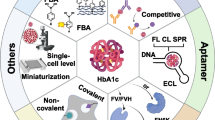Abstract
Diabetes mellitus (DM) is a common non-communicable disease worldwide. Since DM may lead to serious complications, its treatment and care relies on early diagnosis leading to strict glycemic control monitored by the periodic measurement of the patients’ blood glucose levels. However, glucose levels can easily fluctuate due to diet, exercise, insulin resistance, stress, and other factors. Alternatively, the percentage of glycated hemoglobin (HbA1c) in the blood reflects an average glucose concentration over the past 2–3 months with fewer variations due to non-glycemic factors. Therefore, the accurate measurement of the HbA1c in the blood provides a more effective route to diagnose and to monitor DM than a conventional blood glucose measurement. For the measurement of HbA1c, immunoassays have become a widely used method. Therefore, to demonstrate automatic HbA1c measurement, we have developed a microfluidic system to perform a chemiluminescence immunoassay on a single chip automatically except the treatment of samples was undertaken off-chip and required centrifugation. Compared to routine clinical protocols, which rely on bulky benchtop instruments, the developed system is more compact in size (3.8-cm wide and 6.8-cm long) and consumes less samples (volume = 1 μL) and reagents (volume = 150 μL). It is also less labor-intensive to perform an immunoassay using this chip. With further refinements in assay development, this device may be a promising replacement for conventional HbA1c measurement in the near future.






Similar content being viewed by others
Abbreviations
- Bio-MEMS:
-
Bio-micro-electro-mechanical systems
- CNC:
-
Computer numerical control
- DI:
-
Deionized
- DM:
-
Diabetes mellitus
- ELISA:
-
Enzyme-linked immunosorbent assay
- EMV:
-
Electromagnetic valve
- Hb:
-
Hemoglobin
- HbA1c:
-
Glycated hemoglobin
- MEMS:
-
Micro-electro-mechanical systems
- PBS:
-
Phosphate-buffered saline
- PBST:
-
PBS with 1 % of surfactant Tween 20
- PC:
-
Personal computer
- PDMS:
-
Polydimethylsiloxane
- PMMA:
-
Polymethylmethacrylate
- PMT:
-
Photomultiplier tube
- RLU:
-
Relative luminescence units
- rpm:
-
Revolutions per minute
- SA:
-
Streptavidin
- μ-TAS:
-
Micro-total-analysis-system
References
Abraham EC, Perry RE, Stallings M (1983) Application of affinity chromatography for separation and quantitation of glycosylated hemoglobins. J Lab Clin Med 102(2):187–197
American Diabetes Association (2013) Standards of medical care in diabetes. Diabetes Care 36:S11–S66
Choi JW, Oh KW, Thomas JH, Heineman WR, Halsall HB, Nevin JH, Helmicki AJ, Hendersona HT, Ahn CH (2002) An integrated microfluidic biochemical detection system for protein analysis with magnetic bead-based sampling capabilities. Lab Chip 2(1):27–30
Folch A, Ayon A, Hurtado O, Schmidt MA, Toner M (1999) Molding of deep polydimethylsiloxane microstructures for microfluidics and biological applications. J Biomech Eng 121(1):28–34
Huang CJ, Chien HC, Chou TC, Lee GB (2011) Integrated microfluidic system for electrochemical sensing of glycosylated hemoglobin. Microfluid Nanofluid 10(1):37–45
Huang CJ, Lin HI, Shiesh SC, Lee GB (2012) An integrated microfluidic system for rapid screening of alpha-fetoprotein specific aptamers. Biosens Bioelectron 35:50–55
John WG, Gray MR, Bates DL, Beacham JL (1993) Enzyme immunoassay—a new technique for estimating hemoglobin A1c. Clin Chem 39(4):663–666
Kaufman FR, Gibson LC, Halvorson M, Carpenter S, Fisher LK, Pitukcheewanont P (2001) A pilot study of the continuous glucose monitoring system clinical decisions and glycemic control after its use in pediatric type 1 diabetic subjects. Diabetes Care 24(12):2030–2034
Lee WB, Chen YH, Lin HI, Shiesh SC, Lee GB (2011) An integrated microfluidic system for fast, automatic detection of C-reactive protein. Sens Actuators B Chem 157(2):710–721
Little RR, Roberts WL (2009) Laboratory advances in hemoglobin A1c measurement: a review of variant hemoglobins interfering with hemoglobin A1c measurement. J Diabetes Sci Technol (Online) 3(3):446–451
Little RR, Wiedmeyer HM, England JD, Wilke AL, Rohlfing CL, Wians FH, Goldstein DE (1992) Interlaboratory standardization of measurements of glycohemoglobins. Clin Chem 38(12):2472–2478
Maluf N, Williams K (2004) Introduction to microelectromechanical systems engineering. Artech House Publishers, London
Metus P, Ruzzante N, Bonvicini P, Meneghetti M, Zaninotto M, Plebani M (1999) Immunoturbidimetric assay of glycated hemoglobin. J Clin Lab Anal 13(1):5–8
Pecoraro RE, Graf RJ, Halter JB, Beiter H, Porte D (1979) Comparison of a colorimetric assay for glycosylated hemoglobin with ion-exchange chromatography. Diabetes 28(12):1120–1125
Pirart J (1977) Diabetes-mellitus and its degenerative complications—a prospective-study of 4,400 patients observed between 1947 and 1973. Diabetes Metab 3(2):97–107
Rohlfing CL, Wiedmeyer HM, Little RR, England JD, Tennill A, Goldstein DE (2002) Defining the relationship between plasma glucose and HbA1c analysis of glucose profiles and HbA1c in the Diabetes Control and Complications Trial. Diabetes Care 25(2):275–278
Saudek CD, Herman WH, Sacks DB, Bergenstal RM, Edelman D, Davidson MB (2008) A new look at screening and diagnosing diabetes mellitus. J Clin Endocr Metab 93(7):2447–2453
Stöllner D, Stöcklein W, Scheller F, Warsinke A (2002) Membrane-immobilized haptoglobin as affinity matrix for a hemoglobin-A1c immunosensor. Anal Chim Acta 470(2):111–119
UK Prospective Diabetes Study Group (1998) Tight blood pressure control and risk of macrovascular and microvascular complications in type 2 diabetes: UKPDS 38. Brit Med J 352:703–713
Weeks I, Beheshti I, McCapra F, Campbell AK, Woodhead JS (1983) Acridinium esters as high-specific-activity labels in immunoassay. Clin Chem 29(8):1474–1479
Weng CH, Huang CJ, Lee GB (2012) Screening of aptamers on microfluidic systems for clinical applications. Sensors Basel 12(7):9514–9529
Yang YN, Lin HI, Wang JH, Shiesh SC, Lee GB (2009) An integrated microfluidic system for C-reactive protein measurement. Biosens Bioelectron 24(10):3091–3096
Acknowledgments
The authors gratefully acknowledge the financial support provided to this study by the National Science Council in Taiwan (NSC102-2218-E-007-001). Partial financial support from the “Towards a World-Class University” Project is also greatly appreciated.
Author information
Authors and Affiliations
Corresponding authors
Additional information
The preliminary results in this paper have been presented at the 17th International Conference on Miniaturized Systems for Chemistry and Life Sciences, µTAS 2013 Conference, Freiburg, Germany, October 27–31, 2013.
Rights and permissions
About this article
Cite this article
Wu, CC., Lin, HI., Chang, KW. et al. Measurement of glycated hemoglobin levels using an integrated microfluidic system. Microfluid Nanofluid 18, 613–621 (2015). https://doi.org/10.1007/s10404-014-1460-5
Received:
Published:
Issue Date:
DOI: https://doi.org/10.1007/s10404-014-1460-5




